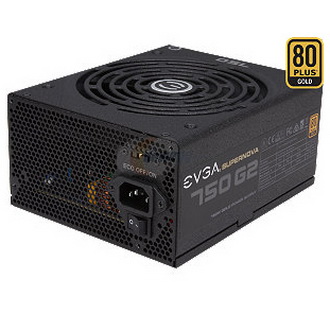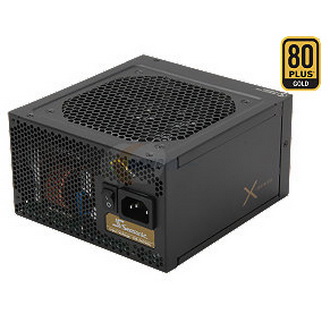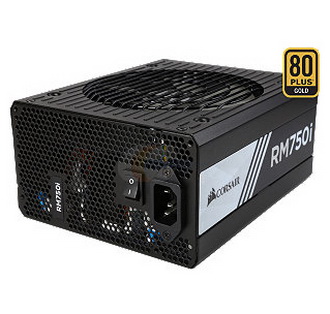Corsair RM750i Power Supply Review
Corsair is revamping its RM line, adding the letter "i" to highlight a more advanced digital interface — today we check out the RM750i.
Why you can trust Tom's Hardware
Load Regulation, Hold-Up Time And Inrush Current
To learn more about our PSU tests and methodology, please check out How We Test Power Supply Units.
Primary Rails And 5VSB Load Regulation
Load Regulation testing is detailed here.
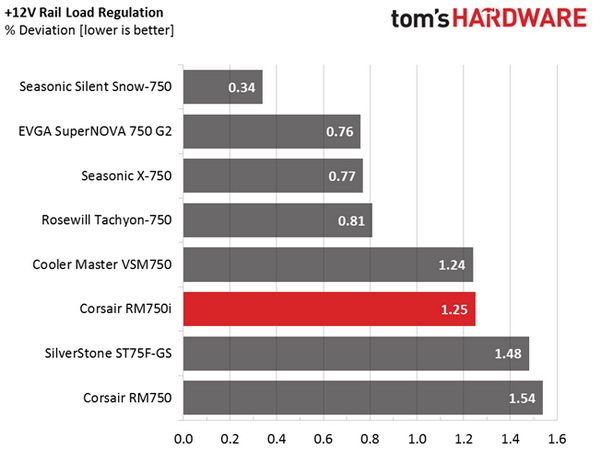
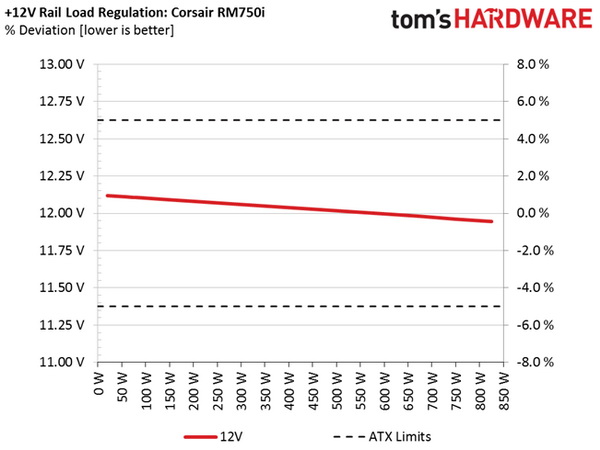

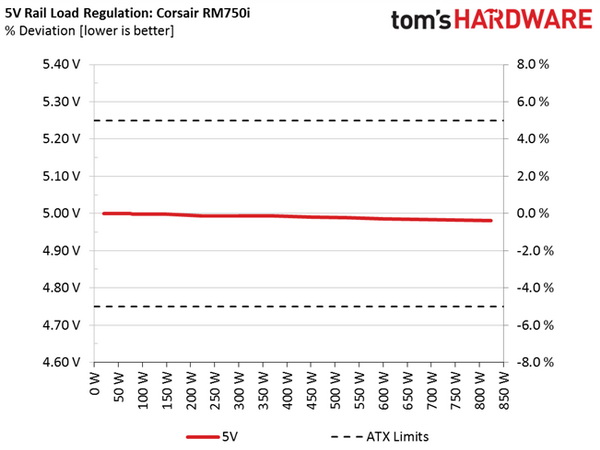
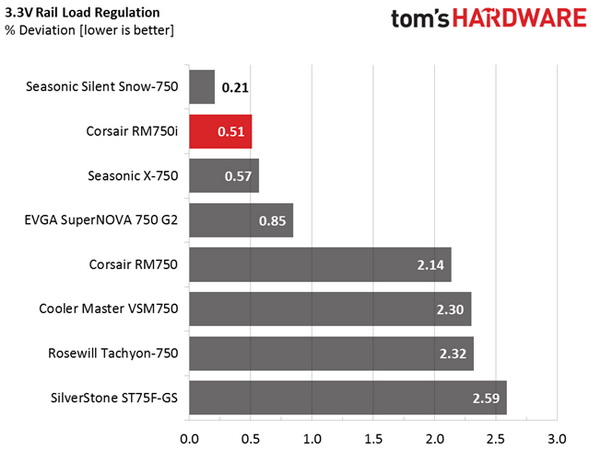
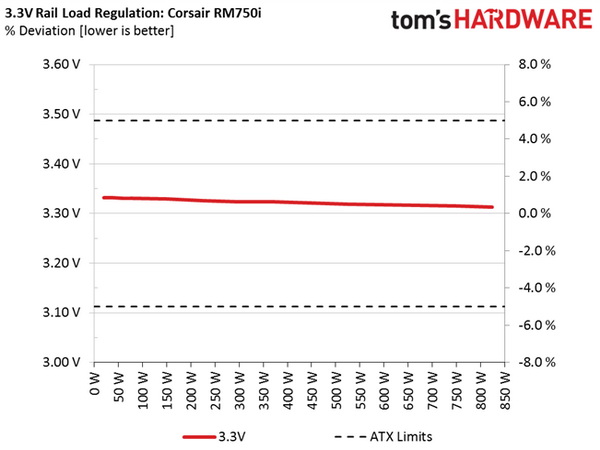
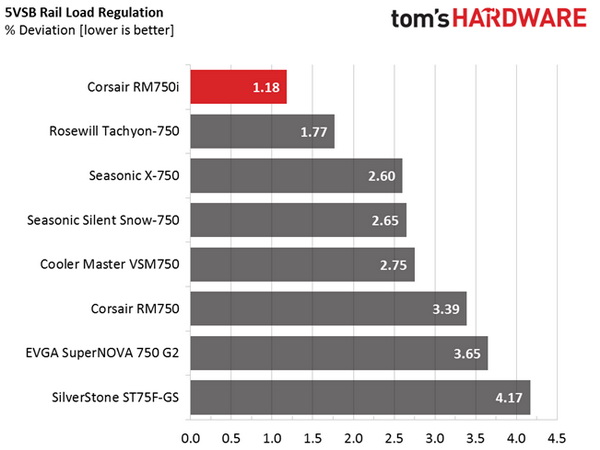

Hold-Up Time
Our hold-up time tests are described in detail here.
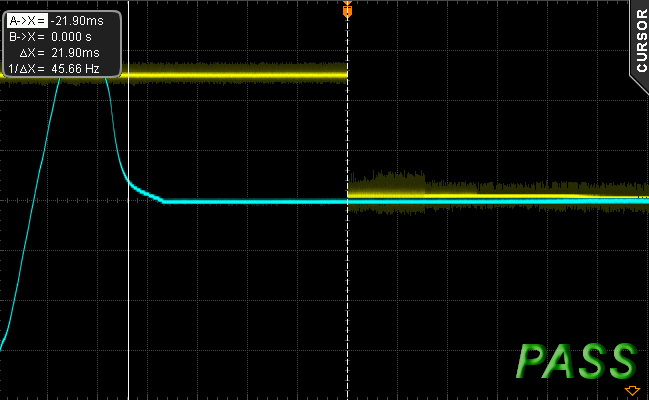
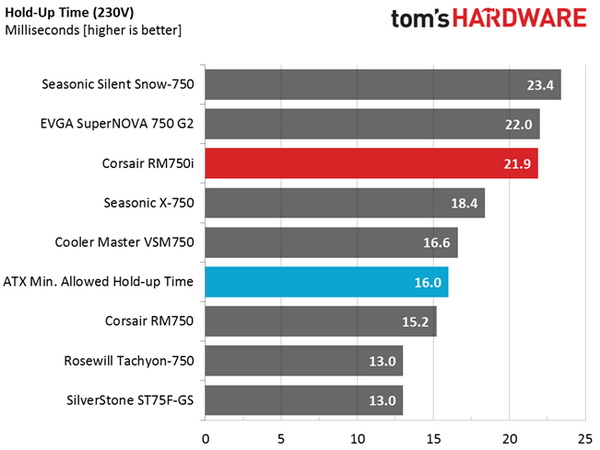
The hold-up time was pretty long, which we expected from the increased combined capacity of the bulk caps.
Inrush Current
For details on our inrush current testing, please click here.
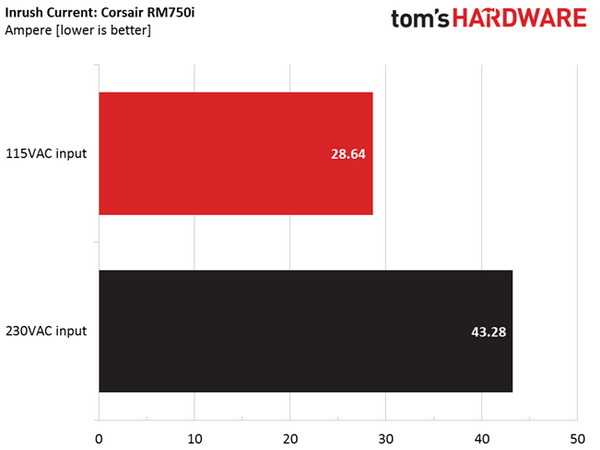

The inrush current is at normal levels for a 750 W PSU equipped with two large bulk caps.
Load Regulation And Efficiency Measurements
The first set of tests reveals the stability of the voltage rails and the PSU's efficiency. The applied load equals (approximately) 10 to 110 percent of the maximum load the supply can handle, in increments of 10 percentage points.
Get Tom's Hardware's best news and in-depth reviews, straight to your inbox.
We conducted two additional tests. During the first, we stressed the two minor rails (5V and 3.3V) with a high load, while the load at +12V was only 0.10A. This test reveals whether a PSU is Haswell-ready or not. In the second test, we determined the maximum load the +12V rail could handle with minimal load on the minor rails.
| Test | 12V | 5V | 3.3V | 5VSB | Power(DC/AC) | Efficiency | Fan Speed | Fan Noise | Temp(In/Out) | PF/AC Volts |
|---|---|---|---|---|---|---|---|---|---|---|
| 10% Load | 4.392A | 2.002A | 1.980A | 1.002A | 74.76W | 84.63% | 0 RPM | 0 dB(A) | 47.44 °C | 0.968 |
| 12.106V | 4.999V | 3.331V | 4.975V | 88.34W | 41.43 °C | 115.1V | ||||
| 20% Load | 9.833A | 3.000A | 2.972A | 1.205A | 149.76W | 88.86% | 0 RPM | 0 dB(A) | 48.34 °C | 0.989 |
| 12.090V | 4.998V | 3.329V | 4.972V | 168.53W | 41.84 °C | 115.1V | ||||
| 30% Load | 15.635A | 3.507A | 3.485A | 1.405A | 224.88W | 90.10% | 0 RPM | 0 dB(A) | 49.87 °C | 0.993 |
| 12.075V | 4.994V | 3.326V | 4.968V | 249.59W | 42.62 °C | 115.1V | ||||
| 40% Load | 21.438A | 4.004A | 3.967A | 1.610A | 299.72W | 90.40% | 0 RPM | 0 dB(A) | 51.39 °C | 0.995 |
| 12.060V | 4.994V | 3.324V | 4.963V | 331.55W | 43.45 °C | 115.1V | ||||
| 50% Load | 26.919A | 4.999A | 4.963A | 1.810A | 374.67W | 90.23% | 0 RPM | 0 dB(A) | 53.71 °C | 0.996 |
| 12.045V | 4.993V | 3.323V | 4.960V | 415.24W | 44.37 °C | 115.1V | ||||
| 60% Load | 32.413A | 6.013A | 5.958A | 2.015A | 449.64W | 89.77% | 488 RPM | 22.4 dB(A) | 41.97 °C | 0.997 |
| 12.028V | 4.990V | 3.321V | 4.955V | 500.86W | 49.09 °C | 115.1V | ||||
| 70% Load | 37.919A | 7.014A | 6.959A | 2.220A | 524.59W | 89.21% | 608 RPM | 25.3 dB(A) | 43.34 °C | 0.997 |
| 12.013V | 4.988V | 3.319V | 4.950V | 588.07W | 50.70 °C | 115.1V | ||||
| 80% Load | 43.446A | 8.022A | 7.957A | 2.423A | 599.56W | 88.63% | 744 RPM | 29.7 dB(A) | 44.85 °C | 0.997 |
| 11.996V | 4.986V | 3.318V | 4.946V | 676.48W | 52.50 °C | 115.1V | ||||
| 90% Load | 49.424A | 8.522A | 8.474A | 2.424A | 674.61W | 87.90% | 848 RPM | 32.6 dB(A) | 45.17 °C | 0.997 |
| 11.979V | 4.984V | 3.316V | 4.946V | 767.49W | 53.15 °C | 115.1V | ||||
| 100% Load | 55.153A | 9.035A | 8.959A | 3.040A | 749.45W | 87.06% | 944 RPM | 34.4 dB(A) | 46.42 °C | 0.997 |
| 11.962V | 4.983V | 3.315V | 4.932V | 860.84W | 54.93 °C | 115.1V | ||||
| 110% Load | 61.504A | 9.039A | 8.963A | 3.040A | 824.37W | 86.23% | 1200 RPM | 41.0 dB(A) | 47.48 °C | 0.997 |
| 11.945V | 4.981V | 3.313V | 4.930V | 956.04W | 56.26 °C | 115.1V | ||||
| Cross-Load 1 | 0.098A | 18.022A | 18.003A | 0.004A | 150.94W | 81.48% | 688 RPM | 26.9 dB(A) | 46.23 °C | 0.991 |
| 12.077V | 4.992V | 3.320V | 5.050V | 185.25W | 53.48 °C | 115.1V | ||||
| Cross-Load 2 | 62.448A | 1.002A | 1.003A | 1.002A | 760.38W | 87.50% | 960 RPM | 34.6 dB(A) | 48.46 °C | 0.997 |
| 11.963V | 4.991V | 3.324V | 4.970V | 869.02W | 56.95 °C | 115.1V |
Load regulation on the +12V rail was good, although we would like to see a reading within 1 percent. On the rest of the rails regulation was much tighter, with the 5V and 3.3V rails easily staying well below 1 percent. In addition, efficiency easily met the 80 Plus Gold requirements with 20 percent and 50 percent load; however, with a full load it was very close to the lower allowed level. As a reminder, the 80 Plus organization conducts the certification tests at only 23 C (73.4 F), while we test at a much higher ambient temperature, so it is natural to measure significantly lower efficiency throughout all load ranges.
In the noise output section, the RM750i carries on the tradition of the RM line with its silent operation, even under extremely tough conditions. Up to the 50 percent load test, the PSU operated in fanless mode, and even when the fan engaged it did so at very low speeds and we had to actually overload the PSU to make the fan's speed exceed 1000 RPM. This is the most silent 750 W we have ever tested and we are pretty sure that this alone will be a key buying factor for many users.
Corsair Link Screenshots
You will find several screenshots of the Corsair Link software below, which we took during our test sessions.
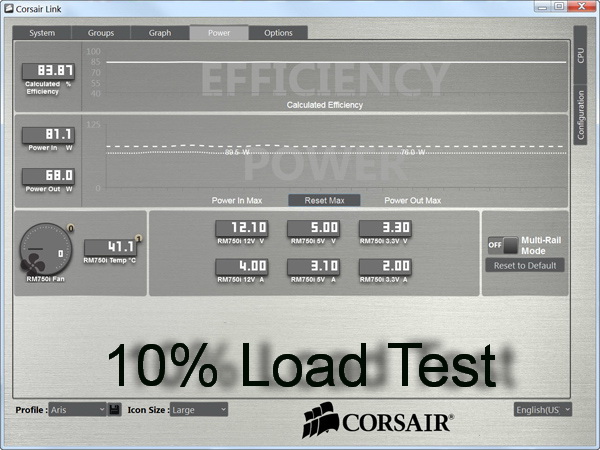
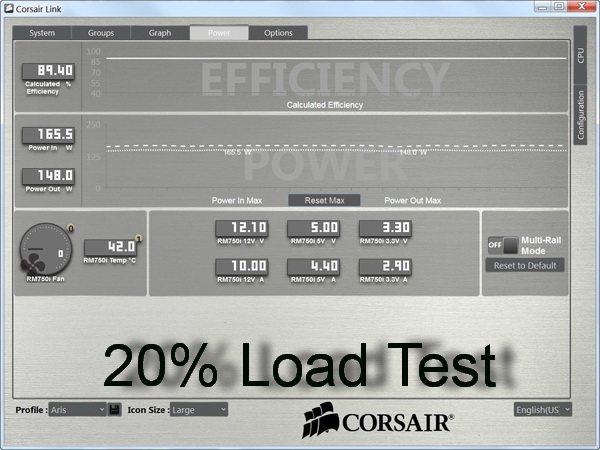

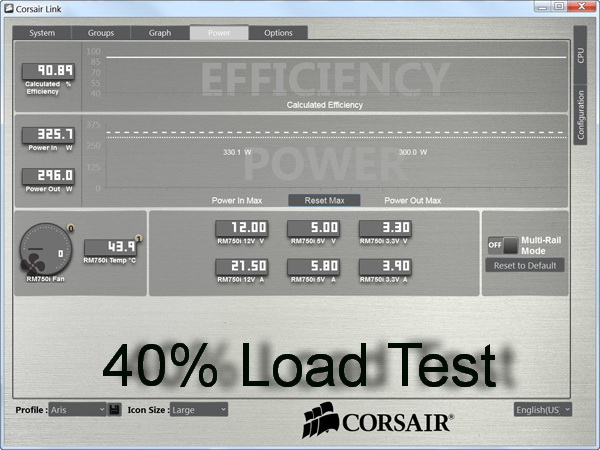
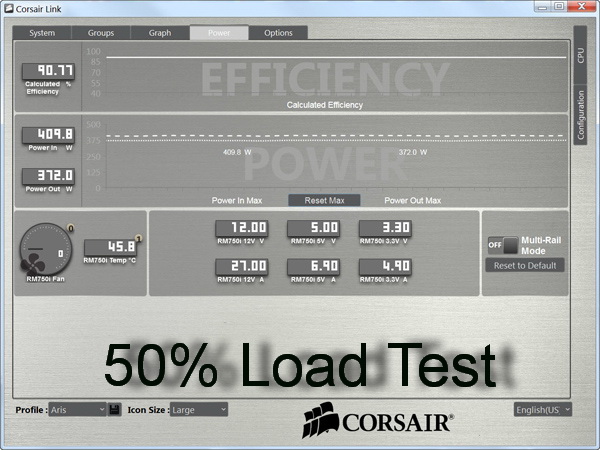


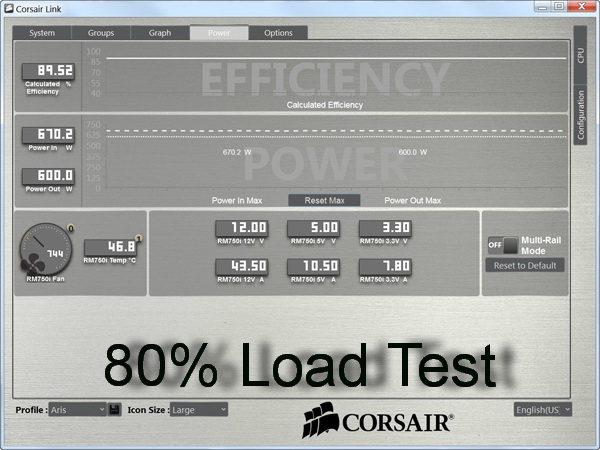
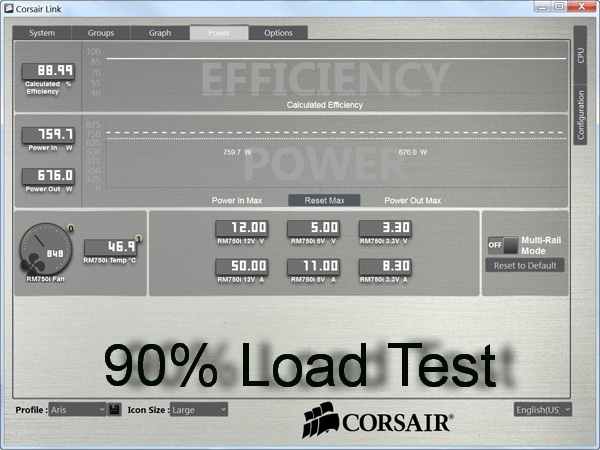

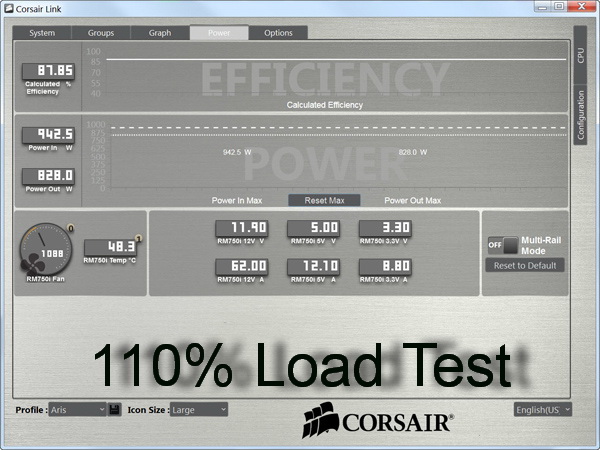
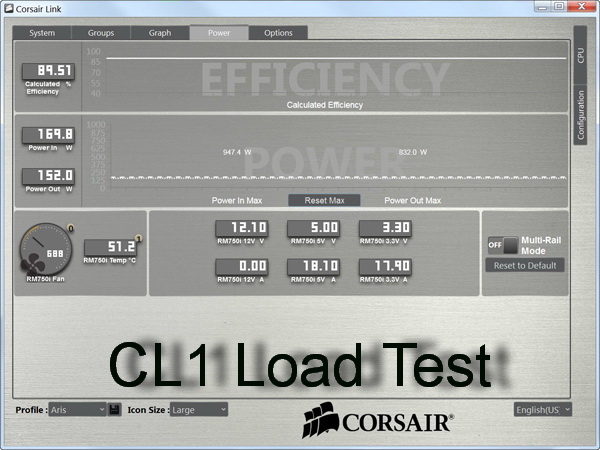

Current page: Load Regulation, Hold-Up Time And Inrush Current
Prev Page A Look Inside And Component Analysis Next Page Efficiency, Temperature And Noise
Aris Mpitziopoulos is a contributing editor at Tom's Hardware, covering PSUs.
-
Luay ArisReply
Thanks for the thorough review.
The RM750i does beat the G2 750 at $10 more, which is a good trade for a mpore quite operation, and is $20 cheaper than the Snow Silent 750, but how does it compare to the $10 more expensive P2 750? -
Aris_Mp I am sorry but I haven't reviewed the P2 750 model yet. However since it is Platinum it should be compared with the HX750i.Reply -
Luay No I'm comparing it based on price.Reply
Since the gold rated RM750i and the platinum P2 750 are $10 apart, excluding the rebate, and as Jonny (The Jonny??) said, a few %s of efficiency isn't as important to me as something as tangible as emitting noise. -
Dan414 This seems like the droids/PSU I've been looking for. That or maybe the 850i. Also, I like the white lettering - that way it will match my case no matter what lighting I have inside.Reply -
synphul I'm confused, there's no other product that compares to the corsair rm750i except the evga g2 750 and the seasonic snow silent 750 which is a higher category and price. Yet isn't that the ss-750km3 sitting at $10 cheaper?Reply
Cwt may be improving but it's not ss quality. Hard to face the two off when they're so close in price or the seasonic is cheaper. I fail to see how it's a better option than the competition. A better option than their own lineup maybe, but that's not saying a ton.
I suppose it's true it comes with corsair link, though with psu's already this quiet not sure the need is there to control the fan beyond active variable control built in and silent mode at low draw. I've never needed to monitor my psu temp or control the fan speed even on a plain old active fan design. Comes off as a bit gimmicky to try and create added value. Don't get me wrong, this would be nice on an otherwise loud psu with no fan control and no silent operation mode at all but in the face of being quiet and having variable/silent fan operation it's a little redundant.
Idk, like I said it's nice to see they're trying to improve quality in some areas but they don't even come in under the competition. As of right now they're more expensive than the competition. Personally I'll stick with seasonic. -
trifler If any PSU companies read this, I want to see molex discontinued, at least on the non-modular power supplies. At least offer some power supplies that don't have molex.Reply -
fil1p It's good to see that all the caps a Japanese on this one. I like Corsair PSUs, but the last gen RM series had some lower quality caps in there, which quite frankly shouldn't have been in an enthusiast PSU at that price point in the first place.Reply -
jonnyguru Reply16336613 said:Cwt may be improving but it's not ss quality.
How do you know? ;-)
16336613 said:I suppose it's true it comes with corsair link, though with psu's already this quiet not sure the need is there to control the fan beyond active variable control built in and silent mode at low draw. I've never needed to monitor my psu temp or control the fan speed even on a plain old active fan design.
You can also monitor voltages and load and calculate efficiency. So it does a lot more than what you're stating.
